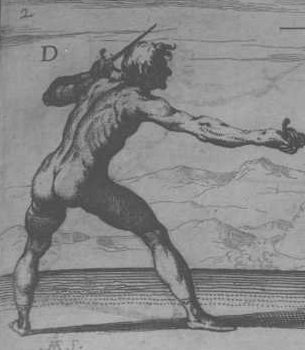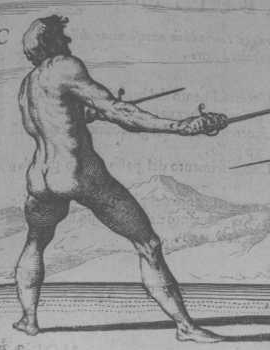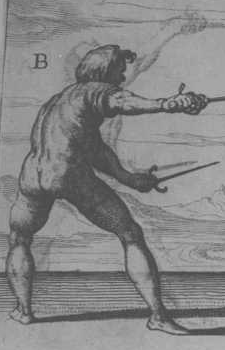It’s been a good year.
At the start of it, I pursued physical therapy to correct a twenty-year-long issue with my left shoulder, and experienced firsthand just how difficult it is to access tiny muscles you never knew existed, and re-learn common movement patterns by telling other, bigger muscles to shut up. Shortly after, I took up yoga. I started teaching historic rapier in formal classes. As summer began, I dived into anatomical studies. I wrote up a fundamentals manual for my students. I began delving into pilates. Recently, I’ve started swing dancing.
All of this has forced me to think much more deeply about movement, and develop a far greater degree of internal awareness. This is good. Six months ago, I did not have the proprioceptive skills necessary to understand the structural changes required to improve my fencing.
A Digression On People Who Win A Lot, and Teaching
There exist “natural athletes”, people with more instinctual control of their bodies, a better innate sense of where they need to be and how to get there efficiently. This proprioceptive/kinetic sense is developed by sports and physical activity, of course, but some people develop faster, or can develop with less input from a less knowledgeable coach. Some kids will learn algebra no matter how bad their teacher is, and some will struggle even with the best.
As previously observed, our teachers and teaching, in the SCA, are generally not very good. As a result, the most successful fencers tend to be those with the most innate advantages – talent, height, etc.
If we want to improve this, we’d do well to begin with a deeper understanding of body mechanics and dynamic movement so we can better teach those who don’t have the “natural athlete” sense.
Finding Stability
To make my point at the end of the previous post a little more concrete, observe Capoferro’s quarta, terza, and seconda:
Note the hips and the angle of the legs. They don’t move. When mutating guards, the upper torso is rotating in isolation. Losing stability during this rotation results in slower, sloppier, weaker actions.
“Easy enough”, you say. You are wrong. Try balancing on an unstable surface (a block of foam would be an easy version) while in guard, maintaining the proper weight distribution. This is challenging by itself, but can usually be accomplished by intermediate-to-advanced historical fencers. When you’ve found your balance, try rotating the upper trunk in isolation. The unstable surface will magnify the effect of any changes in your center of gravity. That’s your weight going somewhere else. Your body has to control and compensate for that. And compensations cost you time and power. Maintaining stability is absolutely essential to performing fluid, quick, and powerful actions. Smoothly transitioning from one strong, ready guard/counterguard to the next. Proceeding with resolution.
Basically, you should be able to do this. Just replace the straight balletic leg with the rear leg in guard. Also, the dancer shown in is rehab, so you should be able to do it better than him. While facing an unpredictable opponent. And performing spontaneous actions.
This is very hard to do.
Similar examples for the spine, scapula, hips, and shoulder exist – perhaps for all the joints, but the proximal ones are the most important. And similar examples exist for all movements in fencing. More dynamic movements require greater stability and control.
You cannot achieve this with “show up and spar”. You cannot achieve this with “drill guard, footwork, and technique, then drill applications at speed, gradually increasing complexity until simulating a real fight.”
Good Form is Not Basic
Consciously accessing the small muscles needed for stable, isolated movement, and turning off the big ones, is EXTREMELY difficult. Novices will not have the proprioceptive skills required for some of the details. These are not basics; these are things to build up as strength and body awareness develop, alongside technique and its applications.
Many people, it seems, think of alignment, balance, control – all that “good form” stuff – as essentially binary, and the purview of beginners (Are you doing the thing? Y/N. If so, great! Let’s move on). Once a novice demonstrates “good enough” in these basics, we start teaching more advanced, fun stuff. But we never, or rarely, come back to hone this foundational work, deepening our mastery of these skills. We get to “good enough” and never get better. We don’t acknowledge that the basics have gradients, and that improvement at the fundamental level trickles up to everything else.
(I think this is a large part of why many HMA practitioners on YouTube, or at Pennsic, can perform plates admirably well in a sterile, choreographed setting but fall into sloppy, athletic sword-tag games when sparring, never using the advanced historical material and rarely even doing the basics well. It’s not just a matter of automaticity or “kata black belts”. Many fencers undermine their own technique by neglecting to develop their body and their form; under stress, they fall apart, losing the stability and control and alignment necessary to perform historical technique. Winning with timing and distance and gaming-the-rules is easier. People do what works, and can’t be blamed for it. But it’s not historical, and it’s not pretty.)
We are never “done” learning form – we simply find smaller and smaller details to perfect. Gains in strength, range of motion, and body awareness must be pursued continually and integrated into our fencing. This is best achieved via very technical, targeted exercises, applying these gains in athleticism to technique, and then reevaluating the tactical and strategic considerations of our better technique.
Each level places more stress on our attention, meaning we need more and more automaticity to be successful. And we gain automaticity only by focusing on doing things right, over and over again, until we can’t do it wrong.
On Goals
On Facebook, Dante lamented that the reactionary response to praising and striving for the perfect record is, eventually, to hold all successes, no matter how small, equally praiseworthy – until the definition of success is watered down and meaningless. This echoes the idea that objective measurement is important, and that we need to identify “good” and “bad” in order to continue to improve. I agree.
When I brought up the counterpoint that “good fencing” goals can be just as objective, and might be more approachable and achievable than “did I win?” goals, the response went along the lines of “if you do things right, then you’ll win.”
The problem is that judging success by wins implies the converse of this heuristic: “if you won, then you did things right.” This isn’t true. We can all remember instances where we did something atrociously wrong, but took the point anyway – because our opponent was having a bad day, or just wasn’t good enough to exploit the mistake, or some element of pure chance went our way. Likewise, I’m sure we all remember times when we were fencing very, very well, at the maximum of our abilities at the time, but still lost because someone else was better.
I can go 10-0 at a small, local event. I can go 3-7 in the wrong pool at Ruby Joust. Externalities affect win percentage. You can try to take these into account, but it does render the measurement less objective.
Furthermore, “winning by doing things right” holds true only if you do most everything right, at the same time. This is difficult enough, and not appropriate if building some smaller novel movement pattern up to automaticity – that’s too much to pay attention to. Instead, the focus should be on “do this one thing right, no matter what. Try to do the other things too, but never at the expense of this very specific primary goal.” It doesn’t matter if I get hit. We’re wearing masks.
As an example: right now, I am working on strengthening different patterns of muscle innervation to maintain better spinal alignment and scapular stability through dynamic motion. Sometimes that means I have to focus so much on what my subscapularis is doing, or the exact position of my T5-T8 vertebrae, that I forget to parry. Whatever. The alternative – focusing on striking my opponent, and slipping into more familiar, worse form – reinforces suboptimal movement patterns, which is a step away from the goal.
Maybe Dante doesn’t need to drill down to this level of single-minded focus – maybe he’s got the innate talent I talked about above. But me? I don’t have that. Neither do most of my students. Neither, I’d wager, do most SCAdians, or most people in general. For me, the focused approach is much better.
Now the ultimate goal should always be to do everything perfectly, and there are times when it’s appropriate to temporarily put more nuanced goals on hold and try to win a lot. But I posit that turning all our focus to a singular, specific goal is the fastest way to achieve it. With this assumption, a goal so broad, and subject to so many externalities, as “win more”, will slow our improvement. I’d say shifting the focus from “do good fencing” to “win” should occur almost never in drill, rarely in sparring, and only sometimes even on the tournament field.
Certainly, we should respect and seek to emulate people who win a lot. Replicating success is a lot easier than reinventing it. But the emphasis should stay on “what is the difference between what I do and what they do? What’s something specific I can focus on?”
After all, if my goal was simply to win more, I’d buy a 38″ and a stick.
Summary
There are a lot of ideas here, and they’re intertwined – or muddled. I don’t feel I’ve expressed them as well as I’d like, partly because my understanding is only halfway developed. But I can say that this narrower focus has brought about a very different proprioceptive quality to my fencing movements – one that feels right, and seems to be reflected in the movements and training of high-level acrobats and dancers and figure skaters, other professions where body control is paramount. At present, I’m determined to pursue it. Maybe it won’t lead to success, but right now I’m quite convinced that the most advanced historical material will forever remain out of our reach without this substantial rigor.



Pingback: Tibbie Crosier
Pingback: Ruairc
Pingback: Dante di Pietro
Pingback: Dante di Pietro
Pingback: Ruairc
Pingback: Ruairc
Pingback: Dante di Pietro
Pingback: Ruairc
Pingback: Dante di Pietro
Pingback: Wistric
Pingback: Ruairc